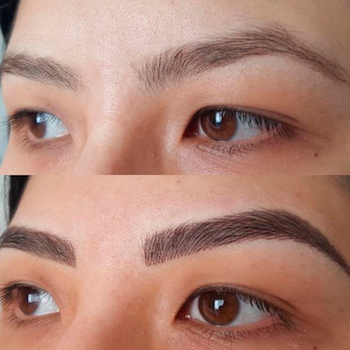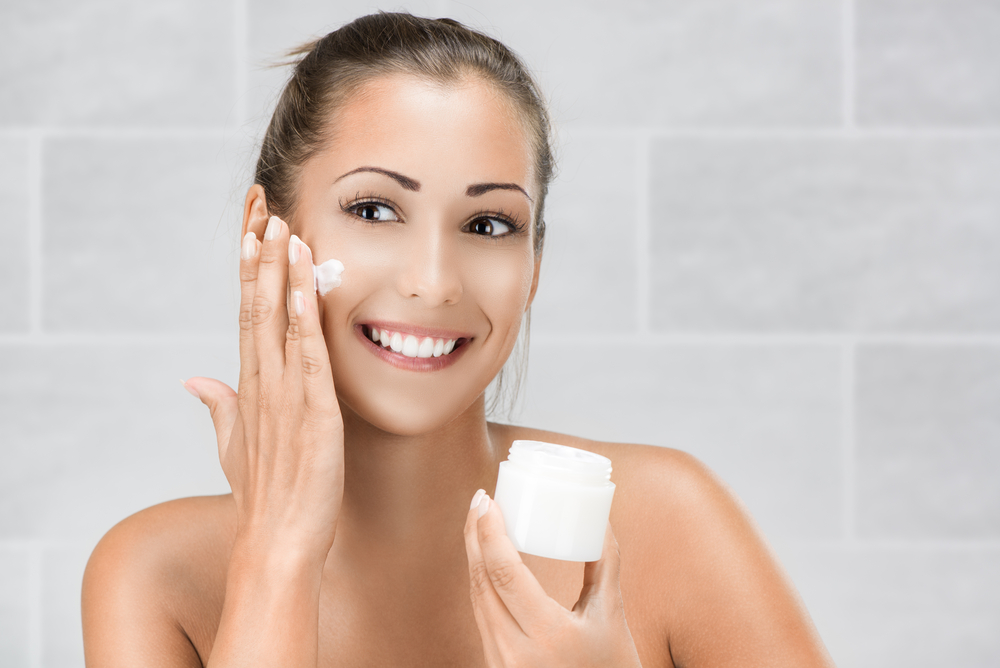- Microshading is a gentler version of microblading, the semi-permanent makeup technique for sparse, light-colored or over-plucked brows.
- Unlike microblading, microshading fills in thin brows with small dots rather than natural hair strokes, which is safer for sensitive or oily skin.
- Each eyebrow artist has their own style so it’s important to choose your technician based on your skin type as well as your desired outcome.
If you’ve always dreamed of picture-perfect brows but have ruled out microblading for its incompatibility with sensitive skin, then you might want to give microshading the technique’s softer, gentler sibling a go.
Microshading vs. microblading
Depending on your skin type and desired results, your brow expert might recommend one or all of the following techniques for the perfect brows:
- Microblading uses a permanent makeup hand tool (usually a bundle of multiple needles) to draw super-fine hairs that mimic natural growth.
- Microfeathering was made famous by Feathered BrowÒ Founder Kristie Streicher, and uses your natural hairs as a base and incorporates the new brow hairs into the existing ones for a more natural look.
- Microshading corrects sparse or thinning brows using a manual tool that administers tiny, pin-like dots in a gradient pattern, creating a semi-permanent powdered effect.
These techniques fall under the greater umbrella of eyebrow microblading. While they differ in application—strokes versus dots, primarily—they’re all achieved by inserting permanent pigment beneath the skin, like a tattoo. Since microshading requires much smaller incisions, it is less likely to cause irritation in people with sensitive skin.
“Microshading uses a stippling method as opposed to hair stroke pigmentation in microblading,” says Boca Raton Dermatologist Jeffrey Fromowitz. “It creates a denser, thicker brow, using dots of pigment instead of strokes, and the results resemble perfectly-applied eyebrow powder.”
Skin type isn’t the only factor when considering permanent brow technique: there is the aesthetic aspect. Microshading is recommended for people who just want a little extra oomph, as opposed to a total brow makeover.
The small, pin-point dots in microshading are subtler and not suited for making big adjustments to shape. Because of its signature gradient appearance, microshading is often referred to as “ombré brows” or “powder fill brows.”
“These techniques are best for individuals who want a natural-looking but well-defined eyebrow which they don’t have to recreate each morning with makeup,” says Dr. Fromowitz.
How long does it last?
Microshading is a semi-permanent eyebrow treatment, and can last for one to three years with proper maintenance; touch-ups are recommended to lengthen results.
Since this new technique replaces the natural-looking hair strokes of microblading with small dots, it may last longer than typical microblading, with the average treatment lasting two years. Note that your skin type, aftercare routine and general lifestyle will affect how long permanent brows last.
Before and after



How much does it cost?
Microshading varies in cost based on your desired outcome, where you live and other factors. In general, permanent eyebrow tattoos cost between $700 and $1,500 for a complete treatment, but you may see prices as low as $300 in some parts of the country.
Because this is a relatively new beauty technique, it is hard to determine a cost average, but microshading often costs the same as regular microblading.
How many sessions are required?
It is possible to achieve perfect brows with microshading in just a single treatment session, but it is not recommended. Usually, the process requires a consultation, followed by a two-hour or longer treatment session and a final touch-up several weeks later.
Some technicians do not require a final touch-up when only light microshading is used. The technique used and your desired results will dictate how much time (and money) will be involved.
Does it hurt?
People often compare the experience of microblading to the feeling of receiving many tiny paper cuts, but less pain is reported in microshading due to the dotting technique. There remains some pain involved since the skin is being incised.
Most good microblading artists opt to numb the area with a topical agent prior to the treatment to make each session more comfortable.
Are there any side effects?
Side effects of microshading are similar to those for microblading—whether you desire wispy, hair-like strokes or small dots, a technician must break the dermal layer using a needle, causing injury. In any scenario, this brings risk of infection.
Common side effects include itchiness, redness, puffiness and swelling immediately after treatment. There are more serious risks for those who trust poorly trained practitioners, such as serious infections of hepatitis and HIV.
Can anyone get microshading?
There are a few conditions that might prevent you from microshading, including:
- pregnancy or breastfeeding
- excessive sebum production from the skin (oily skin)
- overly sensitive skin
- severe acne
- history of keloids or hypertrophic scarring
- allergies to topical anesthetics or to tattoo ink
- rash in the area like eczema or psoriasis
- a previous tattoo in the area that has not faded.
Always consult your dermatologist or physician before booking a microshading appointment.
What’s involved in recovery?
The healing process is vital to ensuring long-term success. Your technician will recommend proper cleansers and aftercare creams to help the brows heal properly and to prevent infection.
Your skin care routine might be slightly altered post-microshading as you won’t be able to wash your face or wear makeup for several days to allow the small cuts to safely scab and shed until they’re fully healed.
It is important to refrain from touching or irritating the area while it naturally heals.
The combo method
Because microshading is subtler, it is often used in conjunction with microfeathering, microblading and other permanent brow techniques. In fact, many artists pair traditional microblading with microshading, especially in patients who have particularly thin eyebrows—and those who want more dramatic results—but who also struggle with dry or challenging skin.
A well-trained brow technician might also use microshading to fill in certain areas, while giving the whole brow the standard blading treatment.
Final thoughts
Microshading can be performed by cosmetic technicians, aestheticians, and permanent makeup artists from a variety of backgrounds.
Make sure that you choose a professional who is well-versed in the art and has some formal microblading training, with a certification by the Society of Permanent Cosmetic Professionals (SPCP) or a reputable cosmetology school.
After you’ve identified a respectable microshading professional, spend some time focusing on their particular style. Microblading is an art more than a science, and one artist’s technique and aesthetic will vary widely from another’s.
Examining an artist’s Instagram, Facebook or website can help you determine if their approach matches your ideal outcome.









